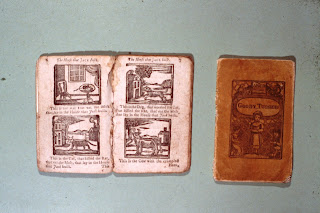"Ev'ry lady in this land
Has twenty nails upon each hand
Five and twenty on hands and feet
And this is is true without deceit"'
(Punctuation Personified, 1824)
The 18th century saw great developments in the use of pictures in books for children. Generally these were crude but vigorous black and white woodcuts; many children's chapbooks in particular had these on every little page, with a short verse underneath.
 |
| Chapbooks, c.1800-1815 (Parker Collection Library of Birmingham) |
 |
| From an American Metamorphosis, Samuel Wood & Sons, 1814, reprinted from a 17th century original (University of Delaware) |
Two variations on these flap books was published by Stacey Grimaldi in the 1820s; The Toilet, and A Suit of Armour for Youth. These show pictures of toilet articles or pieces of armour with titles such as 'An universal and genuine Beautifier' . Lift the flap picture and the moral is revealed: 'Good Humour'. Each picture is followed by an improving poem from Nathaniel Cotton's Visions in Verse.
Grimaldi's Toilet, showing The Enchanting Mirror: Humility
(Copy: Philadelphia Rare Books, Pinterest)
However the true for-runners of modern children's picture books first appeared n the early 1800s, published by John Newbery's equally adventurous successor, John Harris. The earliest, Old Mother Hubbard and her Dog, a verse rendering by Sarah Martin of a traditional tale was published in 1805 and its success encouraged the publisher to commission other little books to follow. These picture books were tales in verse about 15cm high, illustrated with copperplates or wood engravings and sold either in plain black and white or, more usually, hand coloured, often quite beautifully, in delicate watercolours. There was a whole cottage industry, employing children in poor families, working from home hand-colouring these and other illustrations.
The stories were versions of traditional tales such as Cock Robin and Cinderella or fantasies such as The Butterfly's Ball, written by a well known scholar, Mr. Roscoe, for his own children, and first published in The Gentlemen's Magazine. Other popular titles were The Adventures of Seven Wonderful Old Women, Dame Trot and her Cat, and The Peacock's Party, one of the numerous imitations of The Butterfly's Ball.
 |
| Old Dame Trot and her Comical Cat c.1820 (Parker Collection, Library of Birmingham) |
Some of the most delightful of those early picture books are the educational ones; rhyming versions of the rules of punctuation such as Punctuation Personified, or Pointing made Easy, by Mr. Stops which begins:
'Young Robert could read, but he gabbled so fast
And ran on with such speed,that all meaning he lost.
Till one morning he met Mr. Stops, by the way:
Who advised him to listen to what he should say.
Then ent'ring the house, he a riddle repeated,
To show, WITHOUT STOPS, how the ear may be cheated.
"Ev'ry lady in this land
Has twenty nails upon each hand
Five and twenty on hands and feet
And this is is true without deceit"'
(Punctuation Personified, 1824,
Parker Collection, Library of Birmingham)
Marmaduke Multiply's Mirthful Method of Making Minor Mathematicians was published shortly after the defeat of Napoleon, and for 'Twice 11 are 22' shows a tiny child on father's knee, brandishing a large glass full of something unsuitable, crying: 'We'll drink to the hero of Waterloo!' He is probably pleased that nurse will no longer be able to terrify him at bedtime with threats of Old Boney. (Marmaduke Multiply, 1816, Parker Collection, Library of Birmingham)
The series of toy books published by S&J Fuller at the Temple of Fancy, Rathbone Place, London around 1810 combined an improving moral story with cut-out figures. The most well known are the History of Little Fanny, the History of Little Henry and Ellen or The Naughty Girl Reclaimed. There are appropriate outfits for each episode in the character's life with a moveable head, and hats, to slot into the costumes.
 |
| The History of Little Fanny, 1810 (Theriaults The Dollmasters.com) |




